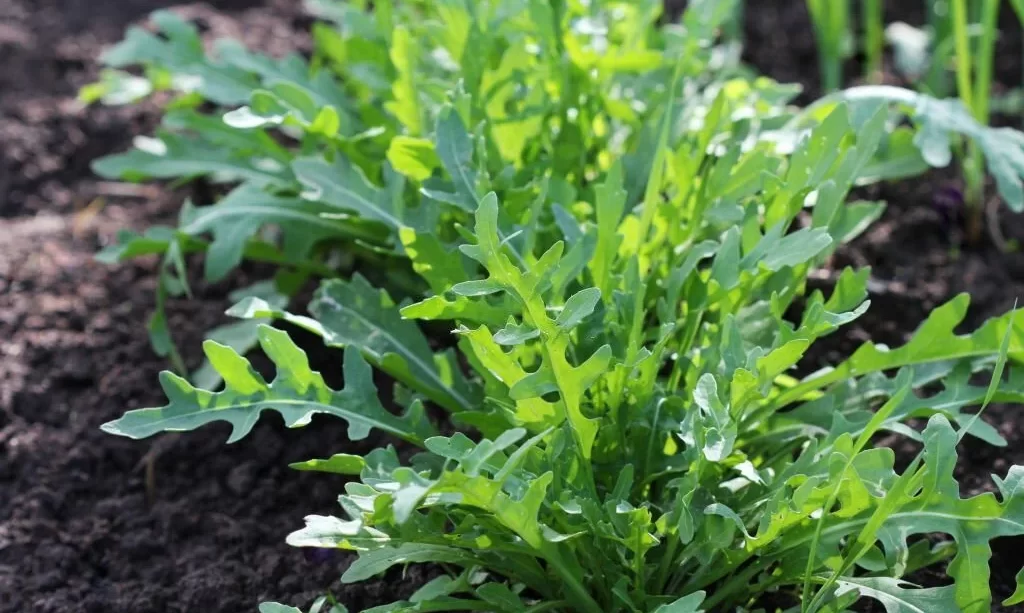Arugula, with its delicate leaves and peppery aroma, is a leafy green that has found its way into the hearts of culinary enthusiasts around the world. But as you savor a salad or dish adorned with these vibrant leaves, you might wonder: Is arugula bitter? In this exploration of arugula’s flavor, we’ll journey into the realm of taste and uncover the nuances of this beloved green. We’ll unravel the mysteries of its unique flavor profile and delve into the question of whether its reputation for bitterness holds true.
- For Microgreens & baby salad greens, vegetable Gardening & More
- High Germination Rate – Non-GMO
- Heirloom Seeds
- Perfect microgreen seeds, sprouting seeds or hydrophonics vegetable seeds.
- Great Flavor, Use in place of any Salad Greens
Arugula’s Flavor Profile
Arugula, known scientifically as Eruca sativa, boasts a flavor profile that sets it apart from other leafy greens. It’s a green that can make your taste buds dance with delight. When you take that first bite, you’ll likely notice its peppery and slightly spicy notes. These characteristics contribute to arugula’s unmistakable and bold flavor, making it a sought-after ingredient in salads, sandwiches, and a variety of culinary creations. But amid this robustness, there’s an underlying question: Does this peppery punch also include bitterness?
The Bitterness in Arugula
Yes, arugula does indeed carry a hint of bitterness within its vibrant leaves. Bitterness is one of the key components of arugula’s flavor profile. This bitterness comes from natural compounds found in the plant, such as glucosinolates. These compounds are not unique to arugula but are present in various members of the Brassicaceae family, which includes arugula, broccoli, and mustard greens.
The perception of bitterness can vary from person to person, and what one individual might describe as pleasantly peppery, another might find slightly bitter. Furthermore, the degree of bitterness in arugula can differ among various arugula varieties and even among leaves from the same plant at different stages of growth.
As we delve deeper into the world of arugula’s flavor, we’ll explore the factors influencing the bitterness of this leafy green and how culinary techniques can either enhance or balance its distinctive taste. So, if you’ve ever wondered about the unique flavor of arugula, read on as we uncover the secrets behind its culinary charm.
Factors Influencing Arugula’s Bitterness
Arugula’s bitterness is not a fixed attribute but rather a characteristic that can be influenced by several factors, making the taste experience variable for those who indulge in this leafy green. Here are some factors that can affect the bitterness of arugula:
- Variety and Growing Conditions: Different arugula varieties can have varying levels of bitterness. Additionally, the conditions in which arugula is grown, such as soil quality, temperature, and sunlight, can influence its flavor. Some arugula varieties are bred to be milder in bitterness, appealing to a broader range of palates.
- Maturity of the Leaves: Arugula’s bitterness tends to increase as the leaves mature. Younger arugula leaves are generally less bitter than their older counterparts. If you prefer a milder flavor, opt for baby arugula, which is harvested at an earlier stage of growth.
- Culinary Preparation: The way arugula is prepared and used in dishes can impact its bitterness. Cooking arugula, such as sautéing or wilting it in a hot pan, can mellow its bitterness, making it a more palatable addition to warm dishes. In contrast, using raw arugula in salads or sandwiches allows its peppery bitterness to shine.
Culinary Uses of Arugula
Arugula’s unique flavor profile, characterized by its peppery notes and a hint of bitterness, makes it a versatile ingredient in the culinary world. Here are some common and creative uses for arugula in the kitchen:
- Salads: Arugula’s peppery bite adds depth and complexity to salads. It pairs wonderfully with fruits like strawberries, nuts, and cheese. A classic arugula salad might include ingredients like goat cheese, walnuts, and a balsamic vinaigrette to balance its flavors.
- Sandwiches and Wraps: Replace traditional lettuce with arugula in sandwiches and wraps for a peppery crunch. It complements a wide range of fillings, from roasted turkey to grilled vegetables.
- Pasta Dishes: Toss arugula into pasta dishes just before serving. The residual heat will wilt the leaves slightly, enhancing their flavor. Arugula works beautifully with pasta, garlic, olive oil, and Parmesan cheese.
- Pizza Toppings: Add a handful of arugula as a pizza topping after the pizza comes out of the oven. Its freshness and peppery flavor provide a delightful contrast to the warm, cheesy goodness.
- Pesto: Create a unique arugula pesto by blending fresh arugula with garlic, pine nuts, Parmesan cheese, and olive oil. The result is a vibrant and slightly bitter pesto that pairs wonderfully with pasta or as a sauce for grilled meats.
Arugula’s bitterness can be a delightful addition to dishes when used thoughtfully. Its distinctive flavor can enhance the overall taste experience, offering a counterpoint to sweeter or milder ingredients. As you experiment with arugula in your culinary creations, you’ll discover its potential to elevate a wide array of dishes, from simple salads to gourmet delights. So, whether you embrace its bitterness or prefer a milder variety, arugula remains a beloved ingredient in kitchens worldwide.
Arugula Varieties and Taste
Arugula comes in various varieties, each with its unique flavor profile. While peppery and slightly bitter notes are common to all, the degree of intensity can differ. Here are some popular arugula varieties and their distinctive tastes:
- Wild Arugula: This variety is often considered the boldest in flavor. Its leaves are small, deeply lobed, and pack a peppery punch with a pronounced bitterness.
- Cultivated Arugula: Cultivated arugula tends to be milder in bitterness than the wild variety. It’s the one you’re likely to find in most grocery stores and is a good starting point for those new to arugula.
- Baby Arugula: Harvested at an early stage of growth, baby arugula offers a milder, more tender taste. Its leaves are smaller and less bitter, making it an excellent choice for those who want to enjoy arugula without overwhelming bitterness.
- Roquette: Often used interchangeably with arugula, roquette is a European variety known for its robust flavor. It falls somewhere between wild arugula and the cultivated kind in terms of bitterness.
- Astro Arugula: This variety is prized for its balanced flavor, with peppery and bitter notes that don’t overpower the palate. It’s a favorite among chefs for its versatility.
- Eruca Sativa: These finest quality, non-GMO, USDA Organic Slow Bolt Arugula (Rocket) seeds produce lush, green leaves with a fresh, slightly peppery taste. Arugula is delicious in salads, pastas, soups and sandwiches.
- For Best Results: Arugula tastes best when the leaves are young, about 2-3″ long. Cut individual leaves as needed. If flowers appear they are edible as well. For a Continuous Harvest: Sow new seeds every 2-3 weeks to enjoy a continuous harvest all season long.
- Freshly Packed: These seeds are packed for the current growing season and will provide high germination rates next year as well.
- Certified Organic: All Purely Organic Seeds are open pollinated, non-GMO (not genetically modified), heirloom, organic seeds. Each Purely Organic Seed Packet carries the USDA Organic Seal signifying that is has passed rigorous standards and been certified organic by a USDA Accredited agency.
- Premium Packaging: All seeds from Purely Organic Products are packaged in individually styled packets ideal for gifts, storage or immediate use. Each packet displays the plant variety on the front with instructions and plant facts on the back.
Personal Preferences and Adaptation
Taste is a highly personal experience, and what one person finds pleasantly peppery, another might perceive as too bitter. Arugula’s unique flavor makes it a polarizing ingredient for some. However, the beauty of culinary exploration lies in adaptation and personalization.
If you’re new to arugula or have been hesitant due to its bitterness, there are ways to adapt and appreciate its distinctive taste. Consider the following:
- Balancing Ingredients: Use ingredients that complement arugula’s flavor. Olive oil, lemon juice, and cheese (such as Parmesan) can balance its bitterness, creating a harmonious dish.
- Culinary Techniques: Experiment with different culinary techniques. Cooking arugula, even just for a brief moment, can soften its bitterness. Try wilting it in pasta dishes or sautéing it with garlic.
- Gradual Incorporation: Start with milder arugula varieties or baby arugula if you’re new to this green. Gradually increase the amount in your dishes as your palate adapts.
- Pairing: Combine arugula with ingredients that you enjoy. Whether it’s sweet fruits, savory proteins, or other salad greens, pairing arugula with flavors you love can make it more appealing.
Conclusion
In the realm of culinary delights, arugula stands as a testament to the diversity of taste. Its peppery notes and subtle bitterness have earned it a cherished place in countless dishes worldwide. The question of whether arugula is bitter is not a matter of a simple yes or no but a matter of perspective and adaptation.
Arugula’s versatility allows it to be enjoyed by those who savor its boldness and those who seek ways to balance its flavor. Whether you embrace its bitterness or use culinary techniques to soften it, arugula remains a vibrant and beloved addition to salads, sandwiches, and various gourmet creations. As you continue your culinary journey, may you find the perfect balance of arugula’s flavors that suits your unique palate.





